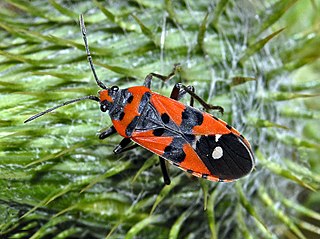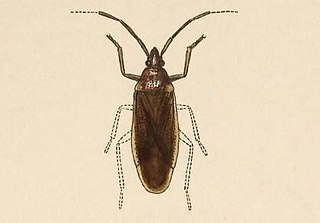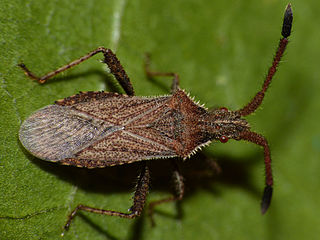
Pentatomidae is a family of insects belonging to the order Hemiptera, generally called shield bugs or stink bugs. Pentatomidae is the largest family in the superfamily Pentatomoidea, and contains around 900 genera and over 4700 species. As hemipterans, the pentatomids have piercing sucking mouthparts, and most are phytophagous, including several species which are severe pests on agricultural crops. However, some species, particularly in the subfamily Asopinae, are predatory and may be considered beneficial.

The Reduviidae is a large cosmopolitan family of the order Hemiptera. Among the Hemiptera and together with the Nabidae almost all species are terrestrial ambush predators; most other predatory Hemiptera are aquatic. The main examples of nonpredatory Reduviidae are some blood-sucking ectoparasites in the subfamily Triatominae. Though spectacular exceptions are known, most members of the family are fairly easily recognizable; they have a relatively narrow neck, sturdy build, and a formidable curved proboscis. Large specimens should be handled with caution, if at all, because they sometimes defend themselves with a very painful stab from the proboscis.

Rhynocoris is a genus of assassin bug, family (Reduviidae), in the subfamily Harpactorinae. Species are recorded from Asia, mainland Europe, Africa and North America.

Anthocoris is a genus of minute pirate bugs in the family Anthocoridae. There are at least 30 described species in Anthocoris.

Rhopalinae is a subfamily of scentless plant bugs in the family Rhopalidae. There are at least 20 genera and more than 170 described species in Rhopalinae.

Lygaeus is a genus of seed bugs in the family Lygaeidae. There are more than 60 described species in Lygaeus.

Lethaeini is a tribe of dirt-colored seed bugs in the family Rhyparochromidae. There are more than 40 genera and 180 described species in Lethaeini.

Trapezonotus is a genus of dirt-colored seed bugs in the family Rhyparochromidae. There are about 19 described species in Trapezonotus.

Gonianotini is a tribe of dirt-colored seed bugs in the family Rhyparochromidae. There are more than 20 genera and 140 described species in Gonianotini.

Rhynocoris ventralis is a species of assassin bug in the family Reduviidae. It is found in North America.

Scolopostethus is a genus of dirt-colored seed bugs in the family Rhyparochromidae. There are more than 30 described species in Scolopostethus.

Phimodera is a genus of shield-backed bugs in the family Scutelleridae. There are about 11 described species in Phimodera.

Macrosaldula is a genus of shore bugs in the family Saldidae. There are more than 20 described species in Macrosaldula.

Micracanthia is a genus of shore bugs in the family Saldidae. There are about 15 described species in Micracanthia.

Galeatus is a genus of lace bugs in the family Tingidae. There are about 18 described species in Galeatus.

Megalonotini is a tribe of dirt-colored seed bugs in the family Rhyparochromidae. There are about 19 genera and more than 80 described species in Megalonotini.
Chiloxanthus stellatus is a species of shore bug in the family Saldidae. It is found in Europe and Northern Asia and North America.

Emblethis is a genus of dirt-colored seed bugs in the family Rhyparochromidae. There are more than 30 described species in Emblethis.

Coriomeris is a genus of leaf-footed bugs in the family Coreidae. There are about 19 described species in Coriomeris.
Rhynocoris marginatus is a species of assassin bug in the family Reduviidae. It is a predator of other insects and is found in Asia. Crops in India on which it has been found feeding on pests include sugarcane, pigeon pea, cardamom, cotton, tea, and peanuts. The insects are potentially useful in biological control because they are more resistant to pesticides than are the pests on which they feed.

















